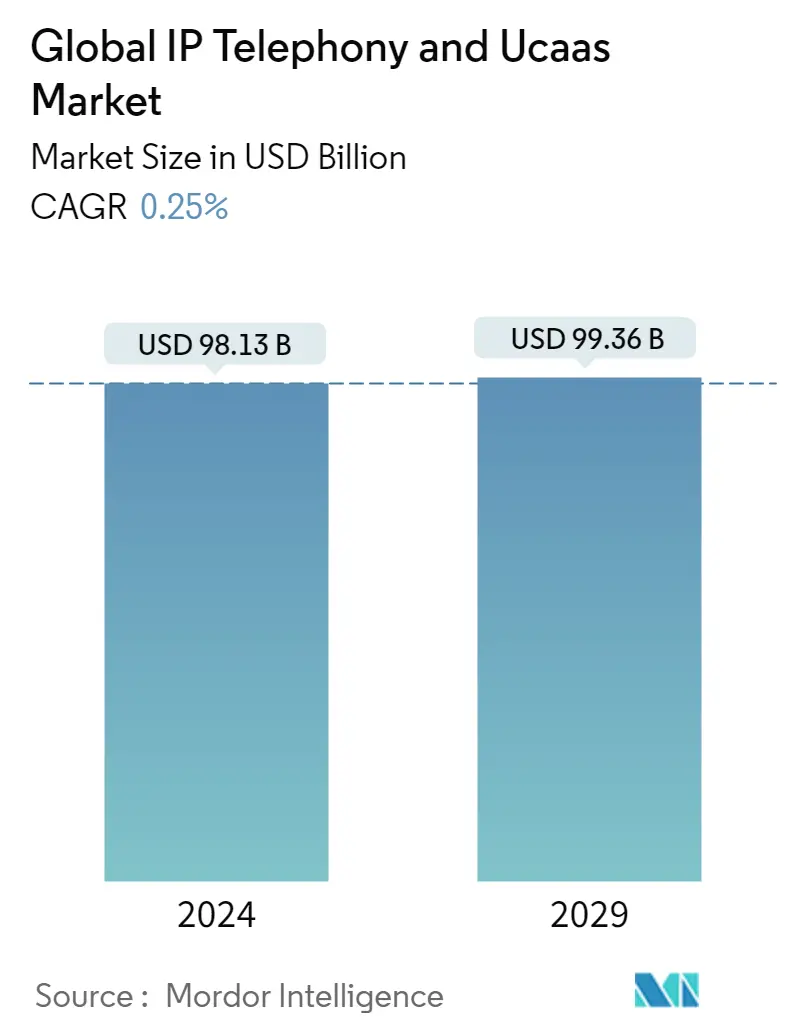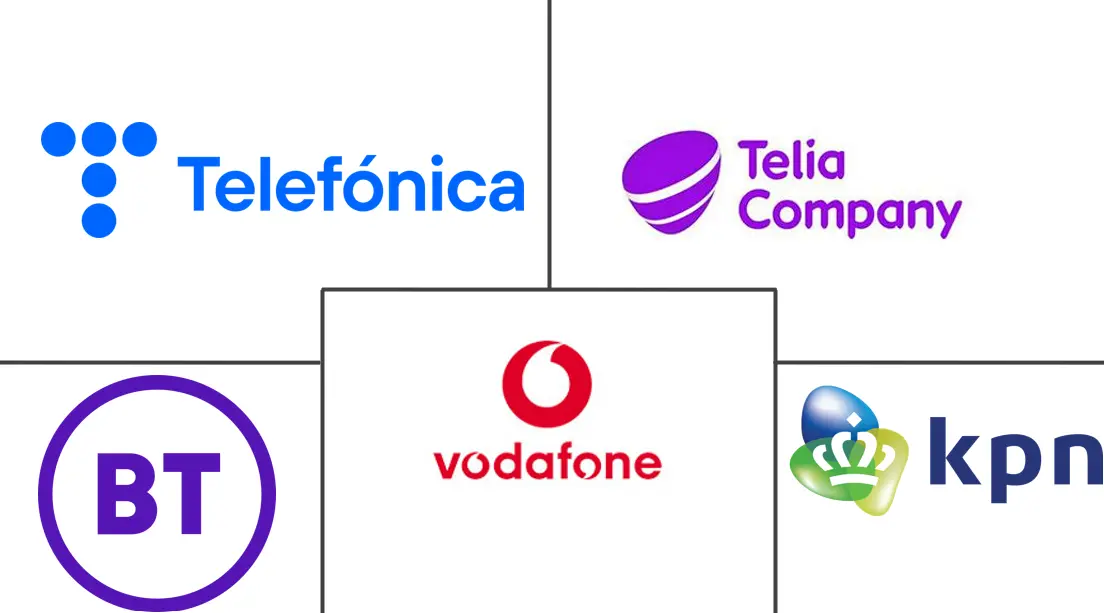Market Size of Global IP Telephony & Ucaas Industry

| Study Period | 2019 - 2029 |
| Market Size (2024) | USD 98.13 Billion |
| Market Size (2029) | USD 99.36 Billion |
| CAGR (2024 - 2029) | 0.25 % |
| Fastest Growing Market | North America |
| Largest Market | Asia-Pacific |
Major Players
*Disclaimer: Major Players sorted in no particular order |
IP Telephony & UCaaS Market Analysis
The Global IP Telephony & Ucaas Market size is estimated at USD 98.13 billion in 2024, and is expected to reach USD 99.36 billion by 2029, growing at a CAGR of 0.25% during the forecast period (2024-2029).
As 2020 marked the whole year of pandemic and economic slowdown, the IP telephony market cumulative revenue contribution by vendors declined. The sharp decline in sales volume for IP phones coupled with a hiccup in initial quarters to provide seamless hosted VoIP service due to unprecedented pandemic affected the market negatively. While cloud-based UCaaS demand increased as employees resorted to remote work and used online mediums for official interactions.
- Unified communications-as-a-service (UCaaS) refers to a service model where the provider delivers different telecom or communications applications, software products, and processes generally over the web. Moreover, IP telephony refers to any phone system that uses an internet connection to send and receive voice data.
- Recently, IP technology has used a variety of protocols to exchange voice, fax, and other forms over the public switched telephone network. The internet protocol became the transport for all data communication. The business telephone system is now able to deliver much more to enterprises. The IP technology has provided a complete communication package over a single network.
- Unified communications provide a more manageable cost structure and a lower acquisition cost. While IP telephony and hardware phones may be required or desired, many businesses get started using a softphone or smartphone app that can replicate the functions of a desktop telephone. However, the pay-as-you-go subscription model is in trend across UCaaS and IP telephony solutions as it provides the best cost structure to customers.
- As UC spending increases, the buying power within the organization rises. Traditionally, IT departments were handing the UC budgets, but the cloud has enabled lines of business to also invest in UC apps.
- The modern workplace is digitizing and shifting. Employees expect more openness, improved collaboration, better technology, and higher flexibility in a workplace. As the workforce continues to become more distributed, with many employees going remote and others working from traditional offices, organizations need the right tools to keep their dispersed workforce always connected.
IP Telephony & UCaaS Industry Segmentation
Hosted IP voice refers to the model where enterprise customers typically purchase or lease the IP-based handsets and/or mobile devices as well as access/connectivity(broadband, private lines, etc.) and the hosted telephony provider assumes responsibility for managing and monitoring all voice traffic. Unified communications-as-a-Service (UcaaS) refers to a service model where the provider delivers different telecom or communications applications, software products, and processes, generally over the web. The unified communication system unifies or integrates all communication methods used by a business into a single platform or multiple communication tools.
Global IP Telephony & Ucaas Market is Segmented by Size of Enterprise Small and Medium Business up to 500 employees, Large Enterprises more than 500 employees, by End User Vertical BFSI, Retail, Healthcare, Government & Public Sector, IT & Telecom, and Geography.The market sizes and forecasts are provided in terms of value in USD billion for all the above segments.
| By Size of Enterprise | |
| Small and Medium Enterprises (Up to 500 Employees) | |
| Large Enterprises (More than 500 Employees) |
| By Application | |
| BFSI | |
| Retail | |
| Healthcare | |
| Government and Public Sector | |
| IT and Telecom | |
| Other End-user Verticals |
| Geography | |
| North America | |
| Europe | |
| Asia-Pacific | |
| Latin America | |
| Middle East and Africa |
Global IP Telephony & Ucaas Market Size Summary
The IP Telephony and UCaaS market is experiencing a gradual expansion, driven by the increasing demand for unified communication solutions that facilitate remote work and enhance collaboration. The market, which faced challenges during the pandemic due to a decline in IP phone sales and initial disruptions in hosted VoIP services, has seen a resurgence in cloud-based UCaaS solutions. These services offer a comprehensive communication package over a single network, providing businesses with cost-effective and scalable options. The shift towards digital workplaces, where employees expect improved technology and flexibility, has further propelled the adoption of UCaaS, particularly in sectors like banking and finance, where effective communication across departments is crucial.
The integration of 5G technology is set to significantly impact the IP Telephony and UCaaS market, offering enhanced speed and bandwidth that will benefit enterprises relying on unified communications. This technological advancement is expected to reduce communication costs for companies with global operations and provide a seamless experience for remote employees. The market is highly competitive, with major players like Vodafone and Ring Central expanding their offerings to meet the growing demand for unified communication solutions. As businesses continue to seek efficient and cost-effective communication tools, the market is poised for further growth, with 5G and edge networking playing a pivotal role in shaping its future.
Global IP Telephony & Ucaas Market Size - Table of Contents
-
1. MARKET INSIGHTS
-
1.1 Market Overview
-
1.2 Porters Five Force Analysis
-
1.2.1 Threat of New Entrants
-
1.2.2 Bargaining Power of Consumers
-
1.2.3 Bargaining Power of Suppliers
-
1.2.4 Threat of Substitute Products
-
1.2.5 Intensity of Competitive Rivalry
-
-
1.3 Industry Stakeholders Analysis
-
1.4 Assessment of the Impact of COVID -19 on the Market
-
-
2. MARKET SEGMENTATION
-
2.1 By Size of Enterprise
-
2.1.1 Small and Medium Enterprises (Up to 500 Employees)
-
2.1.2 Large Enterprises (More than 500 Employees)
-
-
2.2 By Application
-
2.2.1 BFSI
-
2.2.2 Retail
-
2.2.3 Healthcare
-
2.2.4 Government and Public Sector
-
2.2.5 IT and Telecom
-
2.2.6 Other End-user Verticals
-
-
2.3 Geography
-
2.3.1 North America
-
2.3.2 Europe
-
2.3.3 Asia-Pacific
-
2.3.4 Latin America
-
2.3.5 Middle East and Africa
-
-
Global IP Telephony & Ucaas Market Size FAQs
How big is the Global IP Telephony & Ucaas Market?
The Global IP Telephony & Ucaas Market size is expected to reach USD 98.13 billion in 2024 and grow at a CAGR of 0.25% to reach USD 99.36 billion by 2029.
What is the current Global IP Telephony & Ucaas Market size?
In 2024, the Global IP Telephony & Ucaas Market size is expected to reach USD 98.13 billion.

